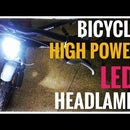Introduction: 3 EASY TRANSISTOR PROJECTS FOR BEGINNERS
Hello Everyone!
In this instructables I will be making 3 Easy Projects using Transistors and some components and Battery.
These are really easy projects that you can do for school project and can be constructed on breadboard and need NO Soldering!.
The list of projects made here are:
- LED Blinker
- Automatic Night Light
- Water Level Buzzer Indicator
Please Watch the Video of making of these circuits.
Step 1: Materials Required
For LED Blinker Circuit
- BC 547 Transistor
- LED
- Breadboard
- Battery 9V
- 10uF Capacitor
- 47 komh resistor
- 100 omh resistor
- Wires
For Automatic Night Light
- BC 547 Transistor
- Breadboard
- Battery 9V
- LDR
- LED
- 100 ohm Resistor
- 47 kohm resistor
- 1 kohm resistor
- Wires
For Water Level Indicator
- BC 547 Transistor
- Buzzer
- LED
- Breadboard
- Battery
- 100 ohm resistor
- 47 komh resistor
- Wires
Step 2: LED Blinker Circuit
This is the simplest working electronic circuit anyone could build. This Circuit is the Electronics version of " Hello World"!
The Pictures show the exact places to mount on the breadboard. You can always follow the circuit diagram for easy understanding. Note the polarity of LED and place them on breadboard.
This is how this circuit works if you are interested. When a transistor is ON it allows current to flow through it so that the LED above it will light up.The two capacitors C1 and C2 will alternate between being charged and discharged and thereby turning the transistors ON and OFF.
Step 3: Automatic Night Light
This circuit senses the light intensity from surroundings and find whether its day or night. A light sensor known as LDR( Light Dependent Resistor) whose resistance varies with Light intensity is used to detect the darkness and automatically turn ON the LED and Turn OFF the LED when there is Light. LDR behaves based on the below mentioned conditions. A pair of Transistors are used to Switch the LED (Load).
High Resistance on LDR= Darkness
Low Resistance on LDR = Brightness
Fun Fact: If you are wondering how Solar Street Lights turn ON and OFF automatically, Similar Circuits will be installed in them.
Connect all the components on the breadboard and power it using the 9V Battery with correct polarity. Cover the LDR Darkness Sensor to test the circuit. The LED Should Turn ON if LDR is covered and turn OFF when Light Falls on the LDR Sensor.
This circuit can be used in living area or garden area as a emergency lighting when there is sudden power outage and can automatically turn ON Light.
This circuit can be combined with a Relay Circuit to Switch 220 V lights. Note: DO NOT attempt this if you are not sure what you are doing because 220 V is hazardous.
Step 4: Simple Water Level Indicator
This circuit detects the water level and sets an Alarm and a LED indication when there is overflow of water. Therefore reminding the user to turn off the water supply and hence saving water.
The basic principle used here is that tap water conducts electricity. When the two probe wires comes in contact with the water the current starts flowing through the probe wires and turns ON the transistor.
Connect all the elements on the breadboard and place the wires on the top of the container. When the water is filled in the container the buzzer beeps.
Step 5: Complete!!
Three easy transistor Projects is completed. These circuits are considered as the learning blocks for electronics beginners and definitely could help to build the skill on breadboard and how to use the breadboard.
These circuit deals with low voltage electricity so even the complete beginner can handle this. Only you could blow up some transistors if the circuit is wrong. LOL :)
Thank you very much for checking out my instructable. Please feel free to post questions and I am open for you suggestions.
Thank you
HS Sandesh Hegde











